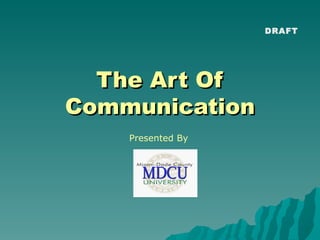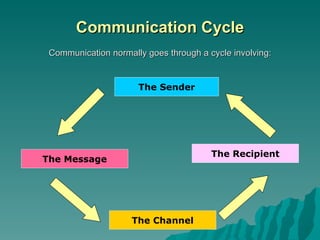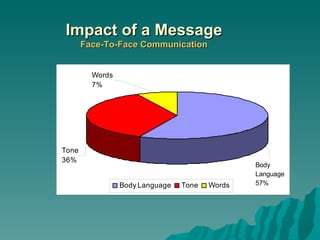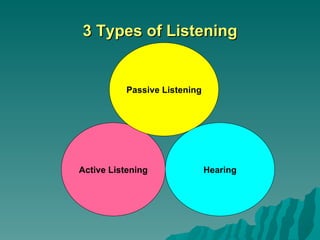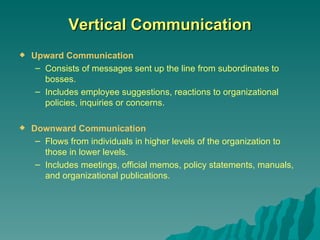Art of communication
- 1. The Art Of Communication Presented By DRAFT
- 2. Learning Objectives What is Communication? The Communication Cycle Impact of a message Types of Communication Styles of Communication Effective Listening Organizational Communication Flow Barriers to Communication Communicating Effectively
- 3. What is Communication? The dictionary defines communication as: A process by which information is exchanged between individuals through a common system of symbols, signs or behavior Communication is a two-way process which involves: Listening to others (Receiving) message Asserting/Expressing (Sending)
- 4. Communication Goals To change behavior To get action To ensure understanding To persuade To get and give Information
- 5. Communication Cycle Communication normally goes through a cycle involving: The Sender The Message The Channel The Recipient
- 6. Impact of a Message Face-To-Face Communication
- 7. Impact of A Message Voice Communication
- 8. 2 Types of Communication Verbal Communication Words Voice modulation Non-Verbal Communication Communicates emotions and attitudes Regulates verbal messages
- 9. Verbal Communication Words Use simple language (avoid jargon and slang) Make sure that you are grammatically correct Be clear and precise (avoid redundancy) Voice Modulation Diction Tone Pitch Volume Rate
- 10. Non-Verbal Communication Gestures Are you aware of how you look to others? Find out your habits and nervous gestures Posture and movement Stand tall Facial Expressions Smile Eye Communication 90% of our personal communication calls for involvement. To show involvement, look at your audience for 5 to 10 seconds before looking away.
- 11. Communication Rights and Responsibilities Rights Responsibilities You have the right to be treated with respect. You have the right to have and express your own opinions. You have the right to ask for what you need in order to be effective. You have the right to set reasonable limits. You have the responsibility to treat others with respect. You have the responsibility to listen to the opinion of others. You have the responsibility to acknowledge and address the needs of others. You have the responsibility to respect the limits and boundaries of others.
- 12. Styles Of Communication Accepts responsibilities. Extends but does not feel entitled to “rights” . Both exercises and extends “rights” and responsibilities. Passive Demands but does not extend “rights”. Does not accept responsibilities. Assertive Aggressive
- 13. Effective Listening Involves. . . . Setting the stage Remove Distractions Be open and accessible Listen with Empathy Ensuring Mutual Understanding Reflect feelings Paraphrase main ideas Seek clarification Confirm next steps Understanding body Language Observe position and posturing Make eye contact Consider expressions/gestures Suspending judgment Concentrate Keep an open mind Hear the person out
- 14. 3 Types of Listening Active Listening Passive Listening Hearing
- 15. Listening and Speaking Listening takes: Concentration and energy Curiosity and open-mindedness Analysis and understanding Speaking requires: Sharp focus Logical thinking Clear phrasing Crisp delivery
- 16. Organizational Communication Flow Downward Instructions Directives Horizontal Coordination Upward Information
- 17. Vertical Communication Upward Communication Consists of messages sent up the line from subordinates to bosses. Includes employee suggestions, reactions to organizational policies, inquiries or concerns. Downward Communication Flows from individuals in higher levels of the organization to those in lower levels. Includes meetings, official memos, policy statements, manuals, and organizational publications.
- 18. Horizontal Communication The horizontal information flow that occurs both within and between departments. Generally, the purpose of lateral communication is coordination and collaboration.
- 19. Barriers To Effective Communication Assumptions Fears Reluctance to confront Ridicule, rejection, fear of being wrong Values and attitudes Generation Gap Information overload When the information we can process is exceeded Trust and Honesty A lack of trust can cause the receiver to look for hidden meanings in the sender’s message. Cross-Cultural Diversity The greater the difference between the sender’s and receiver’s cultures, the greater the chance for miscommunication.
- 20. Key To Communicating Effectively Know your subject. Focus on the purpose. Know your audience. Use a confident tone and a level pitch. Be calm and collected at all times. Try to eliminate excessive “ums” and “uhs” as fillers. Speak slowly and make use of pauses to stress important ideas. Use accurate diction and correct pronunciation Know what you are talking about and accept the limitations of your knowledge. Be vibrant and enthusiastic. Avoid a dull, monotonous tone. Be loud enough to be easily heard .
- 21. . Barriers to communication can lead to misunderstanding and confusion
- 22. Remember. . . Effective communication encompasses a multitude of skills. Skills can be learned and practiced.
